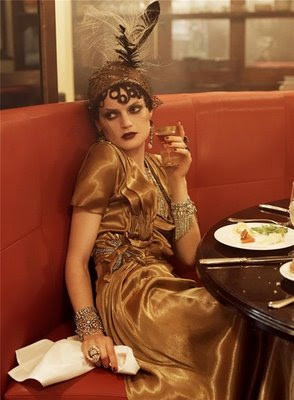 |
Structural lines.
|
Though lines are used to create visual order, one can not forget that they play a huge role in architecture as well. Structural lines are those that give support to a design. These buildings and the crane emphasize their structural lines through repetition and strong grids to create a pleasing aesthetic as well.
Notice the image on the bottom left uses the Rule of Thirds to create good composition. If one drew a tic-tac-toe board over any design, where the lines cross is the best place the focal
point because it aligns with the Golden Mean -- ratios used to create beauty. Placing an object in the center of a design is expected, which is why generally it is better to use the Rule of Thirds to create a strong composition.
 |
Points.
|
Four of the above images use the Rule of Thirds to create a focal point. However, points can also be used to create balance and unity as in the photos in the middle row and the photo on the top left.
 |
Vertical and Horizontal lines.
|
Horizontal and vertical lines, though they establish different objectives on their own, can work together to create order within a space, as seen in the woven back of a chair. The horizontal lines of the blinds (top left) have a calming effect, while vertical lines are used to draw the eye up and evoke a sense of stability and power. The long verticals of the windows give the building a sense of authority and prestige.
 |
Diagonal lines.
|
Diagonals are used in design to create movement and a sense of energy and action. For instance, your eyes are drawn automatically to my self-portrait on the top right. Whether you realized it or not, your eyes were directed there by the diagonals from the pieces to the left and below. The diagonal cross hatching within the self portrait itself give the image a dynamic quality.
 |
| Organic lines. |
Organic lines can give the eye a break from the stiffness that vertical, horizontal, and even diagonal lines can create. Like diagonal lines, organic lines create a sense of movement, but they also have a whimsical quality as well. Organic lines are often found in nature, such as the wave inspired architectural design (top). The organic lines on the vintage car give off an impression of speed, while the entire vehicle uses elegant lines and shapes to produce a sense of glamour.
 |
Implied lines.
|
Implied lines occur when the eye makes the visual leap between to separate objects, and connects them. The holes within the pink fabric and the gaps within the architecture create implied lines through the contrast in value and medium. When backlighting is used within a photograph, it also creates implied lines through the formation of a blunt profile. Though there are gaps between the letters in the sign, the eye automatically makes the jump and visually "connects the dots."
I similar trick was used by impressionists painters to blend color. Van Gogh did not blend is backgrounds so that the gradations between colors were seamless. Instead, he put bold colors right next to each other, causing the viewer to mix the two visually from a distance.
 |
| Geometric shapes. |
Geometric shapes have been used for centuries in design to create intricate patterns or give the illusion of texture. Geometric patterns can add an element of refinement and elegance or they can be used to make a space more modern. Geometric shapes are found in almost every object we come across that is man-made. The bicycle at the top of the collage is an excellent example of how shapes are used in engineering as well.
 |
Organic shapes.
|
Organic shapes can be found anywhere in nature and are considered by some to be the most beautiful. Like organic lines, they give off a sense of freedom -- they can be both alive and alleviating.
 |
Abstract shapes.
|
Though abstract shapes are not realistic, they are representative of the form they are trying to suggest and generally recognizable. Abstract shapes, often inspired by nature, can create beautiful patterns and textures for fashion, textiles, and artwork.
 |
Non-representational shapes.
|
Non-representational shapes are unrecognizable as a specific form; it is because of this that many non-representational designs are over-looked or regarded as unattractive. Most people tend to not like the things that they don't understand. Learning about the elements and principles of art however, can give anyone the tools to analyze and possibly appreciate non-representational designs. It is often more difficult to make a good piece non-representational art that incorporates several elements and principles of design. Non-representational design causes the viewer to think more critically as well. After all, if everyone liked a designer's work than they must be doing something wrong -- nothing is interesting if everyone likes it.
























